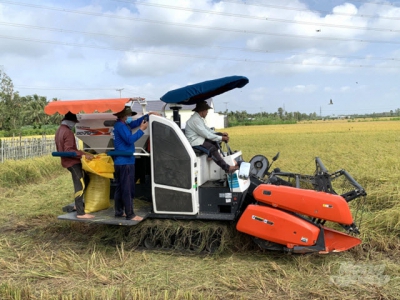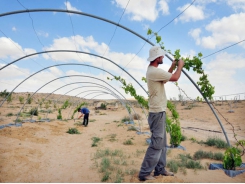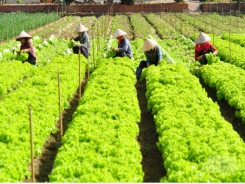Mekong Delta expands sustainable and high-standard rice plant production areas

Producing high-standard, merit, and added value rice plant adapting to climate change based on promoting the strengths, mobilizing the most effective resources.
Towards the mechanization of the entire rice harvest in the Mekong Delta. Photo: HD.
Solid foundation
Agricultural development in the River Delta area in the period of 2021-2030, visions to 2050 according to the Government’s Resolution focuses on the settlement of several problems including the balance of food security and rice crop in the context of climate change, the transformation of infrastructure according to the transformation of development model to improve the economic efficiency, especially in the transformation of agricultural manufacture in some ecological subregions among others.
Accordingly, the direction of agricultural production of high-standard, merit, and added value products adapting to climate change, focusing on fisheries, fruit trees, rice, the livestock according to appropriate proportion to the changes of climate, environment, and product consumption markets.
River Delta region boasts a total rice cultivation area of over 3.9 million ha, accounting for over 54% of the total rice cultivation nationwide. Around 75% of the area, 70% of the various structure in the region used verified rice variety. Over the past years, despite the reduction in area, the average rice plant productivity has remained high, from 56.5 quintals per ha in 2017 to 60 quintals per ha in 2020.
The Rice Research Institute in River Delta picked seven varieties in the total cultivation accounting for nearly 50% of th total cultivation of the whole region. The selected rice varieties are very diverse, suitable for each ecological sub-region, and divided into popular groups such as high-standard, salt-resistant, drought-resistant, and micronutrient-rich.
The Mekong Delta region produces commodity rice to meet market demand. The structure of rice varieties in production changes according to the demand for rice export. The shift was mainly from the group of medium-quality rice to the group of fragrant and high-quality rice. The group of average high-standard rice in export has decreased, this group of rice is mainly consumed domestically for processing products going after rice. Corresponding with the change in variety structure, the exported rice variety also changed from the group of medium quality rice to the group of fragrant and high qual rice. In particular, there is an increase in the group of round grain rice (japonica).
For some subregions affected by salinity, especially coastal regions, the Department of Crop Production cooperated with the localities to proactively prevent the situations by changing the season and structure of rice varieties. Research on selection and use of short-term rice varieties, quality varieties, salinity-resistant varieties, using extreme or short-term varieties. At the same time, vigorously implement the application and transfer of climate change-adapting plant varieties to the Mekong Delta.
MARD orients the research and development of rice varieties to 2025 focusing on researching, selecting, and developing new varieties with high yield, high quality, resistance to pests, diseases, and adverse conditions for domestic consumption and export. The goal is to create and bring the high-standard rice variety into production in the River Delta, with the production value ranging from USD 600 to USD 800 per tons, and resistance to major pests and diseases, and adverse external conditions.
The transformation trend
In addition to research on rice varieties that meet production requirements and rice consumption needs, the transformation of technical advances from institutes and universities together with the VnSAT program (Project on Sustainable Agricultural Transformation in Vietnam) was informed in a training program for farmers in the Mekong Delta. Application of new techniques in farming and plant protection, especially techniques of balanced fertilization, use of rice leaf colorimetric, integrated pest management, "3 reductions, 3 increase" technique, " 1 right, 5 down”, stocking… has been widely applied in production.
In the winter-spring season 2019-2020, there were three enterprises, namely Co Do Agriculture Company Limited, Trung An Company Limited, and Loc Troi Group, which had expanded the production area to over 20,000 hectares, with high-quality fragrant rice varieties such as OM5479, OM249 among others.
Meanwhile, the provinces of An Giang, Kien Giang, Dong Thap, Soc Trang have the strength of concentrated rice production, together with many enterprises implementing production linkages, building raw rice areas according to the cultivation process that ensures safety in line with the standards of SRP, VietGAP, GlobalGAP, organic rice. Up to now, the large-field rice production area in the Mekong Delta is over 427,000 hectares, accounting for over 74% of the country's large field area.
An Giang alone has nearly 30 businesses associated with farmers to produce clean rice, rice verified with GlobalGAP standards for export. Regarding the material area according to Japanese rice standards (Japonica), 400 hectares specializing in sticky rice cultivation and production without using pesticides is ready to supply raw materials at the request of enterprises. It is estimated that there are about 52,000 hectares of raw rice production areas associated with enterprises.
Located downstream of Hau River, along the East Sea, Soc Trang province takes advantage of its land with diverse ecosystems. Currently, the province has built and successfully developed rice production models in the direction of safety and sustainability. Typically, the smart rice-shrimp farming model is strength in creating safe rice products, because rice grown on the ground in shrimp ponds minimizes or does not use pesticides.
Soc Trang province conduced the scheme on developing the fragrant rice specialty on 17,000 ha including the whole area of shrimp -rice production in My Xuyen district. The implementation lasts from 2020 to 2025, vision to 2035, targeting to produce high-quality rice that meets food safety standards.
According to the Ministry of Agriculture and Rural Development, the main salt-resistant and drought-resistant rice varieties have been researched and selected, such as the group of salt-resistant from 2-3% rice varieties: OM6976, OM5451, OM9921, OM5621, OM6677, ST5...; Group of 4% salt-resistant rice varieties: A red bush, OM2517, OM9577, OM5464…
The group of drought-resistant and salt-resistant rice varieties: OM7347, OM5464, OM6162, OM7398, OM7364, OM8928, and OM6677.
Có thể bạn quan tâm
Phần mềm

Phối trộn thức ăn chăn nuôi

Pha dung dịch thủy canh

Định mức cho tôm ăn

Phối trộn phân bón NPK

Xác định tỷ lệ tôm sống

Chuyển đổi đơn vị phân bón

Xác định công suất sục khí

Chuyển đổi đơn vị tôm

Tính diện tích nhà kính

Tính thể tích ao hồ



 Hung Yen longan, agricultural products overcome Covid-19
Hung Yen longan, agricultural products overcome Covid-19  The rise of Ido longan in converted land
The rise of Ido longan in converted land